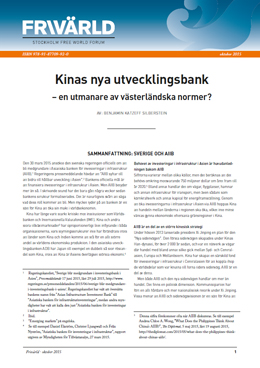The past summer saw the launch of a new Chinese financial institution for development called the “Asian Infrastructure Investment Bank” (AIIB). Sweden was one of the countries that chose to participate from the start – a hardly uncontroversial decision in and of itself.
On the surface, the purpose of the AIIB is to increase infrastructural investments in Asia. However, Beijing sees the AIIB as an economic-political project that seeks to increase China’s economic strength on the Asian continent. It is also uncertain how the AIIB will affect the World Bank’s and the International Monetary Fund’s influence on the global economy. Concerns that the AIIB will challenge Western norms of democracy and market economy are now starting to arise.
These are some of the topics covered in the new report ”China’s New Bank for Development – A Challenger to Western Norms?”
– The AIIB is such a new project that it is currently impossible to deduce the organization’s significance on the global political playing field. Since Sweden has been a member from the very beginning, we have an opportunity to emphasize that the bank’s work should be characterized by transparency, market economy and open competition, said Benjamin Katzeff Silberstein, the author of the report.
– The establishment of the AIIB can affect Asia’s economical and political development in the future and, by extension, the current global world order. Sweden’s membership in the AIIB has not been given enough attention. Benjamin Katzeff Silberstein’s report is an important addition to this debate, said Erik Brattberg, director of the Stockholm Free World Forum’s global trade and development program.

Benjamin Katzeff Silberstein is a fellow at the Stockholm Free World Forum and a Ph.D student in history with a focus on East Asian studies at the University of Pennsylvania. Benjamin has previously worked as a political advisor at the Swedish Ministry of Foreign Affairs and an editorial writer at Svenska Dagbladet, where he continues to regularly contribute. Benjamin is the author of the book Pictures from North Korea, along with Villy Bergström. His articles have been published in Jane’s Intelligence Review, North Korean Review and The Diplomat, among others.
